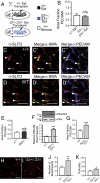Vascular Robo4 restricts proangiogenic VEGF signaling in breast
- PMID: 20498081
- PMCID: PMC2890778
- DOI: 10.1073/pnas.1001896107
Vascular Robo4 restricts proangiogenic VEGF signaling in breast
Abstract
Formation of the vascular system within organs requires the balanced action of numerous positive and negative factors secreted by stromal and epithelial cells. Here, we used a genetic approach to determine the role of SLITs in regulating the growth and organization of blood vessels in the mammary gland. We demonstrate that vascularization of the gland is not affected by loss of Slit expression in the epithelial compartment. Instead, we identify a stromal source of SLIT, mural cells encircling blood vessels, and show that loss of Slit in the stroma leads to elevated blood vessel density and complexity. We examine candidate SLIT receptors, Robo1 and Robo4, and find that increased vessel angiogenesis is phenocopied by loss of endothelial-specific Robo4, as long as it is combined with the presence of an angiogenic stimulus such as preneoplasia or pregnancy. In contrast, loss of Robo1 does not affect blood vessel growth. The enhanced growth of blood vessels in Robo4(-/-) endothelium is due to activation of vascular endothelial growth factor (VEGF)-R2 signaling through the Src and FAK kinases. Thus, our studies present a genetic dissection of SLIT/ROBO signaling during organ development. We identify a stromal, rather than epithelial, source of SLITs that inhibits blood vessel growth by signaling through endothelial ROBO4 to down-regulate VEGF/VEGFR2 signaling.
Conflict of interest statement
Conflict of interest statement: D.Y.L. is employed by the University of Utah, which has filed intellectual property surrounding the therapeutic uses of targeting Robo4 and with the intent to license this body of intellectual property for commercialization.
Figures




Similar articles
-
Robo4 is a vascular-specific receptor that inhibits endothelial migration.Dev Biol. 2003 Sep 1;261(1):251-67. doi: 10.1016/s0012-1606(03)00258-6. Dev Biol. 2003. PMID: 12941633
-
Robo4 stabilizes the vascular network by inhibiting pathologic angiogenesis and endothelial hyperpermeability.Nat Med. 2008 Apr;14(4):448-53. doi: 10.1038/nm1742. Epub 2008 Mar 16. Nat Med. 2008. PMID: 18345009 Free PMC article.
-
Slit2-Robo4 signalling promotes vascular stability by blocking Arf6 activity.Nat Cell Biol. 2009 Nov;11(11):1325-31. doi: 10.1038/ncb1976. Epub 2009 Oct 18. Nat Cell Biol. 2009. PMID: 19855388 Free PMC article.
-
Role of ROBO4 signalling in developmental and pathological angiogenesis.Biomed Res Int. 2014;2014:683025. doi: 10.1155/2014/683025. Epub 2014 Feb 6. Biomed Res Int. 2014. PMID: 24689049 Free PMC article. Review.
-
Slit/Robo Signaling Pathway in Cancer; a New Stand Point for Cancer Treatment.Pathol Oncol Res. 2019 Oct;25(4):1285-1293. doi: 10.1007/s12253-018-00568-y. Epub 2019 Jan 4. Pathol Oncol Res. 2019. PMID: 30610466 Review.
Cited by
-
Retargeting of gene expression using endothelium specific hexon modified adenoviral vector.Virology. 2013 Dec;447(1-2):312-25. doi: 10.1016/j.virol.2013.09.020. Epub 2013 Oct 15. Virology. 2013. PMID: 24210128 Free PMC article.
-
The role of Slit-Robo signaling in the regulation of tissue barriers.Tissue Barriers. 2017 Apr 3;5(2):e1331155. doi: 10.1080/21688370.2017.1331155. Epub 2017 Jun 8. Tissue Barriers. 2017. PMID: 28598714 Free PMC article. Review.
-
The small GTPase ARF6 regulates protein trafficking to control cellular function during development and in disease.Small GTPases. 2019 Jan;10(1):1-12. doi: 10.1080/21541248.2016.1259710. Epub 2016 Dec 21. Small GTPases. 2019. PMID: 28001501 Free PMC article.
-
A Slit/miR-218/Robo regulatory loop is required during heart tube formation in zebrafish.Development. 2011 Apr;138(7):1409-19. doi: 10.1242/dev.060046. Development. 2011. PMID: 21385766 Free PMC article.
-
Navigation rules for vessels and neurons: cooperative signaling between VEGF and neural guidance cues.Cell Mol Life Sci. 2013 May;70(10):1685-703. doi: 10.1007/s00018-013-1278-4. Epub 2013 Mar 12. Cell Mol Life Sci. 2013. PMID: 23475066 Free PMC article. Review.
References
-
- Klagsbrun M, Eichmann A. A role for axon guidance receptors and ligands in blood vessel development and tumor angiogenesis. Cytokine Growth Factor Rev. 2005;16:535–548. - PubMed
-
- Wang B, et al. Induction of tumor angiogenesis by Slit-Robo signaling and inhibition of cancer growth by blocking Robo activity. Cancer Cell. 2003;4:19–29. - PubMed
-
- Kaur S, et al. Robo4 signaling in endothelial cells implies attraction guidance mechanisms. J Biol Chem. 2006;281:11347–11356. - PubMed
Publication types
MeSH terms
Substances
Grants and funding
LinkOut - more resources
Full Text Sources
Other Literature Sources
Molecular Biology Databases
Miscellaneous

